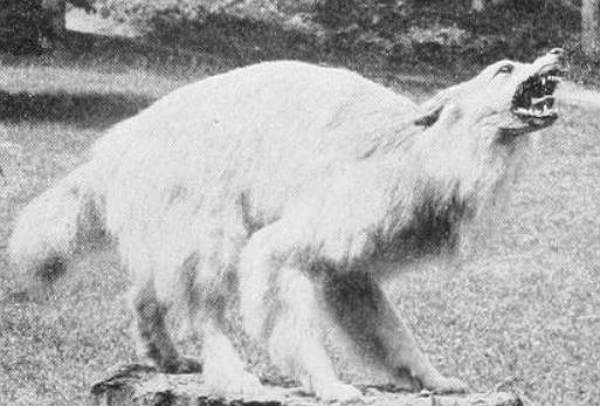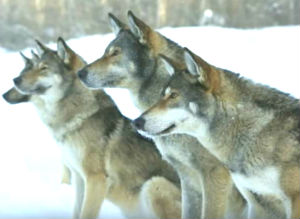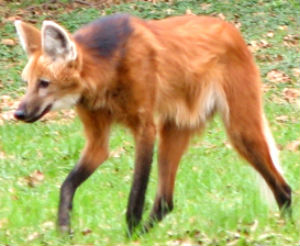Wolf-dog Hybrids
Canis lupus × Canis familiaris
|
|
EUGENE M. MCCARTHY, PHD GENETICS
|
I myself saw at Rome, a dog generated of a wolf, and at Naples, a she-wolf of a dog.
—Giambattista della Porta Natural Magic, 1658 |
Extensive natural hybridization occurs between these two canids in North America and Eurasia. Wolf-dog hybrids are produced wherever both dogs and wolves are present. This cross is also common in captivity. There are currently approximately 300,000 such captive hybrids in North America alone.
Such hybridization usually, but not always, involves a female wolf. The hybrids, called wolf-dogs, are partially fertile in both sexes. The ancients called a wolf-dog a lyciscus.
In a large-scale study involving about 100 animals, Iljin (1941, p. 405) reported that all hybrids in the first filial generation (F1 generation), as well as the F2 and F3 generations, were capable of producing offspring.
Wolves enter heat once a year, in winter, while dogs do so twice, or in some breeds, three times annually. Iljin reported that all F1, and most F2, hybrids entered heat once a year, in late fall. The gestation period in hybrids was about the same as that of a wolf or dog (60-63 days).
There are fears among conservationists that wolf-dog hybris threaten the genetic integrity of the wolf. Walker (2005) argues that extensive hybridization with domestic dogs contributed to the extinction of C. lupus in Japan. Boitani (1983, p. 263) says such hybridization is also threatening the remaining wolf populations in the mountains of southern Italy, where wolves are far outnumbered by dogs, and dog-like hybrids seem at an advantage because they are not persecuted by humans.
Black coloration in wild wolves (Canis lupus) is the direct result of wolves interbreeding with domestic dogs (Anderson et al. 2009). “Domestication of dogs has led to dark-colored coats in wolves, which has proven to be a valuable trait for wolf populations as their arctic habitat shrinks,” according to study coauthor Marco Musiani, a wolf expert at the University of Calgary. “It also shows that human activities can help enrich the genetic diversity of wild animal populations.”
Through genetic analysis of wolf populations from North America and Europe, the researchers traced the source of the dominant gene responsible for dark coat color in wolves to domesticated dogs and concluded the trait was passed to not only wolves, but also coyotes, by means of hybridization with domestic dogs. These hybridization events could have taken place, they say, as recently as the arrival of European dogs in North America or as long as 14,000 years ago, when humans first migrated to North America.
Since then, black fur has become common in wolf packs, perhaps because snow-covered northern regions are shrinking, and darker coloring allows for greater stealth while hunting in areas without snow. While wolves can be found in colors ranging from white to gray to black, light-coloration is predominantly found in the arctic tundra where wolves prey on caribou.
With tundra habitat expected to decline in coming years due to northward expansion of boreal forests related to global warming, the researchers note that black coloration may also help wolves survive in a changing environment.
Article continues below
Various domestic breeds are known to be derived from wolf-dog hybrids. One such breed of recent origin, with a well-known history is the Chinese Kunming wolf-dog, which was produced primarily from crosses between wolves and German shepherds. Others are the American Tundra Shepherd, the Czechoslovakian Wolfdog, and the Saarloos Wolfhound. And there are probably other breeds whose origins are lost in time, but which did in fact come into being in this way. For example, in his History of Four-footed Beasts (1608), Edward Topsell says mastiffs had their origin in this cross, but if this is true, no one would be able to say for sure today. Thus, he comments that "it is ordinary for Wolves and Dogs to couple together, as by experience it hath been observed: And it is certain, that Mastive Dogs had their first beginning from this copulation."
Wolf-dog hybrids have been known since ancient times. Thus, Aristotle (History of Animals, Ch. XXVII, 8) comments that “in Cyrene the wolves mate with the dogs, and produce young.” Pliny (Natural History, Book VIII, lxi) says the ancient Gauls intentionally bred their dogs with wolves, and that “and their packs of hounds have, each of them, one of these dogs, which acts as their guide and leader. This dog they follow in the chase, and him they carefully obey; for these animals have even a notion of subordination among themselves.” Zirkle (1935, p. 14) notes that this cross, and the fact that it is reversible, is mentioned in the Zend-Avesta which dates to an earlier period (700-400 BCE) than either of the authors just mentioned. Galen also mentions wolf-dog hybrids.
Indeed, wolf-dog hybrids were known even in prehistoric times. Walker and Frison (1982) analyzed canid skulls from several Wyoming archaeological sites and found that canid remains, originally identified as wolf were actually wolf/dog hybrids, which indicates “constant and continua1 backbreeding” to wolf. Bökönyi (1975) reports a probable hybrid from a prehistoric site in Hungary.
Among the aboriginal peoples of North America such hybridization has been commonplace. In his journal describing a trip through the interior of North America in the early 19th century, Maximillian, Prince of Wied, describes such hybrids:
Audubon and Bachman, who also travelled the U.S. frontier in the 1800s, say they
(License: Malfuros, Wikimedia)
Freuchen (1935) says Inuits intentionally cross their dogs with wolves. And Valadez et al. (2006) report that archaeological studies demonstrate that hybrids of this type were also commonly kept by the pre-Hispanic peoples of central Mexico.
whose grand-mother was a Wolf
whose father and grand-father were dogs, and whose
mother was half Wolf and half Dog. She died
on the 16th of October, 1782, aged 12 years.
 Wolf-collie hybrid found on Grand Island in Lake Superior in 1917 (Source: Fuertes and Baynes 1919, p. 87).
Wolf-collie hybrid found on Grand Island in Lake Superior in 1917 (Source: Fuertes and Baynes 1919, p. 87).
A list of dog crosses
The following is a list of reported dog crosses discussed on this site. Some of these crosses are much better documented than others (as indicated by the reliability arrow). Moreover, some are extremely disparate, and so must be taken with a large grain of salt. But all have been reported at least once.
|
|
By the same author: Handbook of Avian Hybrids of the World, Oxford University Press (2006).
References: Andersone et al. 2002; Audubon and Bachman 1851-1855; Bell 1837 (p. 198); Boitani 1983; Bökönyi 1975; Broca 1859; Buffon (1749-1804, Supplement, vol. 3, pp. 8-14); Darwin 1868 (vol. 1); 1883 (vol. 1, p. 23); Flourens 1845 (p. 122); Geoffroy Saint-Hilaire 1849 (p. 56), 1862 (pp. 177, 217); Gesner 1560 (p. 211); Godinho et al. 2011; Haag 1948; jHerre 1965; Iljin 1941; International Zoo Yearbook 1971 (p. 272), 1972 (p. 325), 1972 (p. 329), 1974 (p. 378), 1977 (p. 314); Nowak 1973, 1979; Olsen and Olsen 1977; Ryabov and Bibikov1982; Hunter 1787; Morton 1847b (p. 273); Scaliger (1612, p. 648); Vilà and Wayne 1999; Vilà et al. 2003; Walker and Frisson 1982; Wied 1906 (quoted by Walker and Frison 1982); Young and Goldman 1944 (pp. 208-210).
“The leaders lifted the yelp of the pack and sprang away into the woods. The wolves swung in behind, yelping in chorus. And Buck [the giant sled-dog main character of the book] ran with them side by side with the wild brother, yelping as he ran. And here may well end the story of Buck. The years were not many when the Yeehats noted a change in the breed of timber wolves; for some were seen with splashes of brown on head and muzzle, and with a rift of white centering down the chest.”
 Wolf-dog hybrids
Wolf-dog hybrids Dog/maned wolf hybrids
Dog/maned wolf hybrids